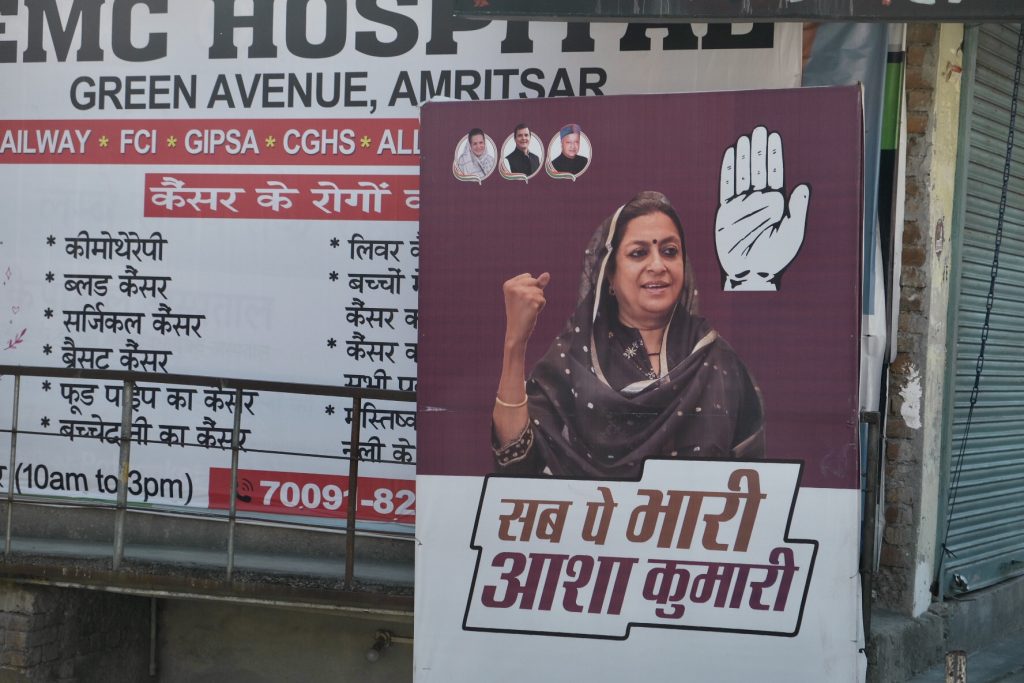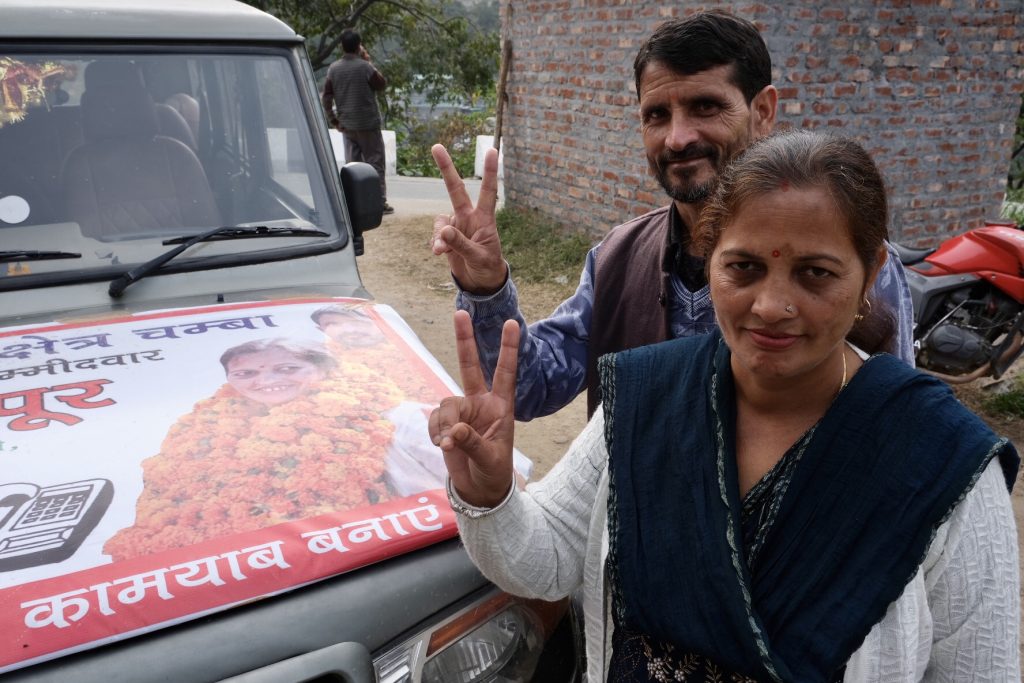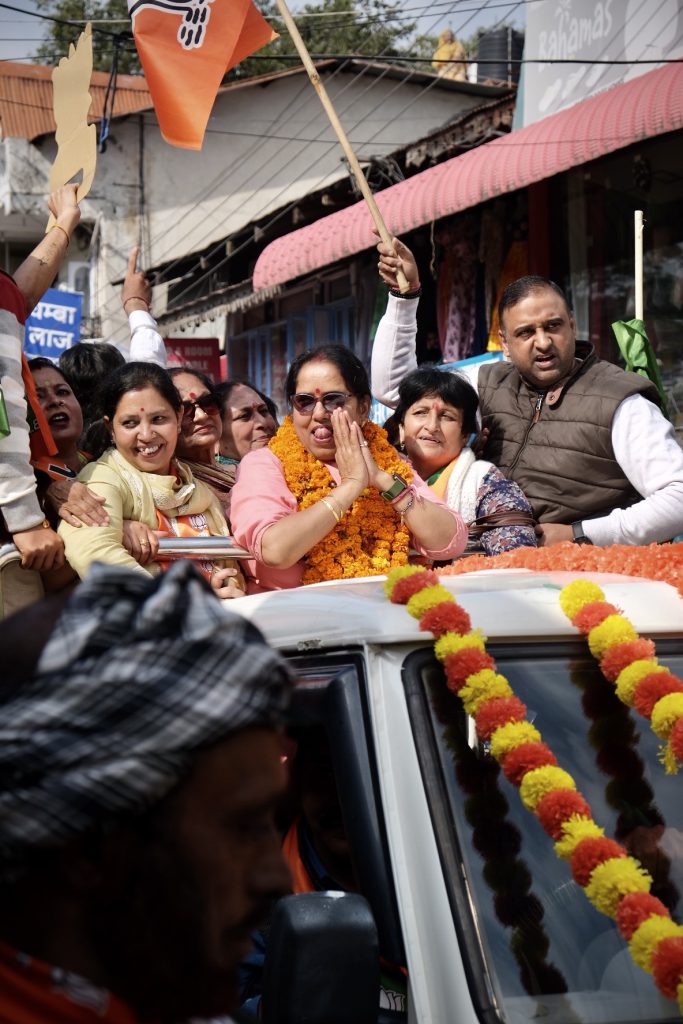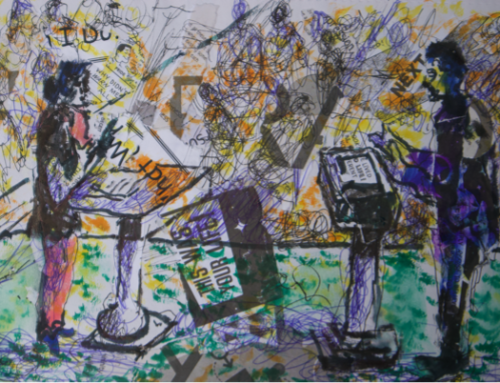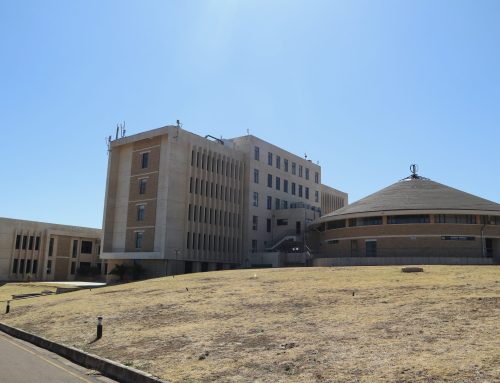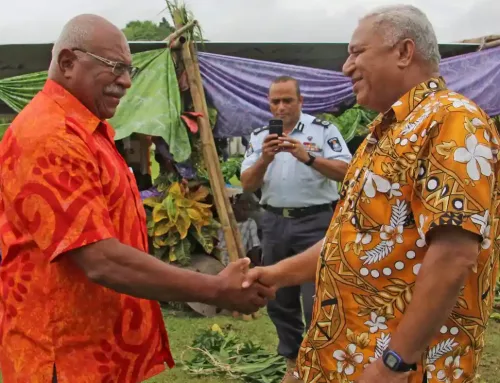Based on fieldwork in the Indian state of Himachal Pradesh, Vidya Venkat argues that poll statistics do not fully capture the complexity of women’s participation in electoral contests.
In November 2022, voters in the India state of Himachal Pradesh went to the polls to select the 68 members of the state’s legislative assembly. Ahead of the elections, news channels and the Internet were abuzz with analysis of election numbers. One such analysis carried out by the Association of Democratic Reforms noted that of the 412 candidates contesting in the elections fielded by various political parties, only 24 candidates, accounting for a lowly six percent, comprised of women. The number by itself is quite stark in exposing the poor participation of women in the electoral battle and establishes political leadership as a male bastion.
However, ethnographic field research allowed the GRNPP team on the ground in Himachal to uncover much more than what this statistic could reveal. This blog aims to make two arguments: i) Numbers do not capture the complex sociological dynamics involved in electoral battles on the ground. ii) Not all women in the electoral fray can be treated alike by clubbing them into a single statistic based on their gender identity.
Chamba district has five assembly constituencies – 1. Churah 2. Chamba 3. Dalhousie 4. Bharmour and 5. Bhattiyat. As part of the short study visit, Dr. Richard Axelby and I jointly interviewed three women candidates and three male candidates in the electoral fray covering Chamba, Dalhousie and Bharmour constituencies, which gave me an opportunity to study and compare their responses and campaigns on an equal footing. I also interviewed a former woman panchayat sarpanch in Chamba to get a sense of the barriers before women in entering state-level or national-level politics.
As I was entering Chamba district, driving down from the nearest airport in Amritsar in November this year, the very first election campaign poster that caught my attention was that of Asha Kumari, a veteran Congress leader who has been elected as MLA six times from Dalhousie assembly constituency previously. One could not miss her prominent hoardings dominating the hill landscape, claiming with confidence: “Sab pe bhaari, Asha Kumari” (She weighs heavily on them all, that is Asha Kumari). Of the 68 members of the 13th State Legislative Assembly that sat from 2017 to 2022, Asha Kumari was one of only three women MLAs. But in the election of November 2022, she faced stiff competition from a male BJP challenge. With the voting phase over, we met the widowed daughter-in-law of the erstwhile Raja of Chamba, Lakshman Singh, at their summer palace in Dalhousie, the Jandrighat Palace. Sitting outside in the cold winter sun, Asha Kumari addressed a large gathering of supporters there seated around a bonfire. We joined her gathering, and it felt as though we were attending a royal queen’s durbar (court) there. The gathering comprised of Congress party workers, businessmen, panchayat leaders, and other locally influential persons. Kumari was very confident that the Congress would win the elections in Himachal and the overall public support was clearly on their side. It was clear from our interaction with her that Kumari could not be viewed only as one of the six women candidates in the electoral fray. Let me cite an observation. As we entered the summer palace to reach the seated lawn area where the bonfire had been arranged, Asha Kumari’s daughter greeted us before introducing us to her mother. While Richard and I shook hands with the mother and daughter, Vinayak Dhami, our local research collaborator, made a gesture of touching both their feet. Such gestures are normally reserved for elderly members of the family or community in India, which demonstrated the immense respect and regard the members of the erstwhile royal family continued to evoke in Chamba. Asha Kumari undoubtedly benefited from the family clout her position as a royal family member bestowed upon her in Chamba. Moreover, her brother T.S. Singh Deo is health minister in the Chhattisgarh state government. In response to a question whether her identity as a woman ever made her feel vulnerable in the political realm that she had never felt that way and had held national-level assignments for her party which often required her to travel far and wide in Punjab and other places in India as the former All India Congress Committee in-charge. Inside the palace, we saw pictures of Kumari shaking hands with the former Prime Minister Rajiv Gandhi and greeting former President APJ Abdul Kalam, which indicated the deep personal connections she enjoyed with those holding high political office. Kumari also spoke about how being a small state, the electorate in Himachal Pradesh constituencies usually numbered in the thousands, which meant that it was fairly easy to maintain personal relations with voters, whom she had now known for generations now. I enquire from Asha whether she feels women bring something different to the role of MLA; Asha starts by saying there’s no difference whether man or woman. But goes on to say that women politicians are better able to connect with other women and children. Is there a downside? “Male politicians might say about me ‘you can’t have a drink with her, you can’t socialise with her’. But I am there for the welfare of the people, not to lead people to drink and do drugs.”. Was this comment a dig at her opponent who was accused of offering alcohol to voters? Asha concludes: “it’s not a handicap being a woman”, though, of course, not everyone enjoys the enviable social and political capital she holds.
A complete contrast with Kumari was Indira Kapoor, an independent candidate competing from Chamba, who served as a zilla parishad ward councillor in Chamba previously. Kapoor had initially won a ticket to contest as a BJP candidate, however, the party decided to back another candidate, Neelam Nayyar, wife of the incumbent MLA in Chamba, Pawan Nayyar, for the post. Kapoor was convicted in a corruption case pertaining to her role as a zilla parishad member but managed to receive a stay order from the HP High Court which allowed her to contest the election. Since she had served as a BJP functionary for 30 years now, the party’s decision to field a replacement candidate made her feel betrayed. Kapoor had a strong vision for Chamba’s development. She said that there was an urban-rural divide in Chamba and most leaders here in the past had hailed from urban backgrounds with the result that the developmental needs of the rural population was often overlooked. She hailed from the tribal Gaddi community and was keen to work for the welfare of women in the constituency. She even spoke of pushing for 33% reservation for women candidates within the party if she won the MLA seat. But despite the promise for leadership she showed, the lack of money and social capital most likely disadvantaged Kapoor in keeping her position as an MLA candidate. Kapoor too had been encouraged to pursue a career in politics by her husband, but she seemed to have come into her own as a politician, and said she enjoyed much support among women in Chamba.
The woman who took Kapoor’s position as BJP MLA candidate, Neelam Nayyar, was fairly open during her campaigning that she was in this position thanks to her husband and also because she had the backing of the senior BJP leadership. Her campaign posters made a fairly obvious statement in this regard. Mrs. Nayyar was a picture of humility with folded hands, flanked by her husband on one side, and the senior leaders of the BJP above her picture on the poster. Unlike the Congress candidate from Chamba Neeraj Nayyar, Neelam had no personal statement whatsoever she had to make regarding her candidature besides parroting the party line. When we asked her why she would like voters to support her candidature, she said that having a BJP government at both the state and the Centre would lead to a “double engine” sarkaar, meaning that there will be better cooperation between the national and state governments leading to a smoother flow of funds for development. She was merely repeating what other BJP leaders had been saying elsewhere. Her husband’s tenure as Chamba MLA had seen a boost in construction of roads and pathways in a hill town ridden with connectivity issues, and Nayyar, who got into politics after cementing his position as a public works contractor had an obvious vested interest in promoting road laying projects. Therefore, his wife too highlighted the need to improve connectivity as a major goal to pursue if she was elected to power. During our interaction with Mrs. Nayyar it was obvious that she was here as a representative of her family, having been initiated into politics by her father-in-law and husband. She cut her teeth in politics as the President of the municipal council in Chamba and said that the job taught her a lot about interacting with the public and resolving their day-to-day issues. Mrs. Nayyar once again demonstrated the advantages of family connections in pursuing a political career.
To understand the low participation of women in electoral contests, it is important to consider how family connections, wealth and access to political mobility were key to propel women into a successful career in public life. A chat with Sakina Begum, who had previously been the gram pradhan (village head) of Paliyor panchayat in Chamba, helped throw light on the barriers facing women aiming for more prominent roles. Hailing from the Muslim Gurjar community, Begum enjoyed unanimous support from Hindu and Muslim communities in her village for her candidature, but she found it difficult to manage the pressures of the pradhan’s job with three children to raise and a husband whose NGO salary only afforded them a frugal lifestyle. Today, Begum runs her own handmade jewellery and apparel shop, with which she manages to meet her needs, but the products need better marketing in order to sell better, she admits. When I asked Begum why she did not consider contesting in the state-level polls, she noted wryly that it was simply beyond her reach…
To conclude, it is evident from the analysis of the candidature of the three women presented here that a numerical analysis of candidates based on gender fails to capture the socio-economic diversity of the candidates. To cite anthropologist Sally Engle Merry then, it is necessary that studies of electoral politics transcend the “seduction of quantification” and explore instead the complex on-the-ground situations accounting for the relevant cultural context[1]. Yet in terms of diversity, the results of the 2022 election leave little room for comparison. Of the 24 women who stood, only one was successful in gaining election to sit alongside the 67 male MLAs in the Himachal Pradesh State Legislative Assembly.
[1] Merry, S. E. (2016). The seductions of quantification: Measuring human rights, gender violence, and sex trafficking /. The University of Chicago Press.

